Abstract
This paper gives insight into the language propaedeutics when educational activity focuses on presenting economic processes through graphic modeling. The contents of this paper were motivated largely by the experience and outcomes of instruction in modeling economic processes intended for international as well as Russian students at the faculties where all the instruction is carried out in English. The article relates the need for propaedeutics to several reasons, the main of which are the choice of vocabulary used, the appropriate range of grammar and lexis, as well as mastering practical skills at graphic modeling of economic processes in a way that transcends the limits of and engages students in the actual practice of using mathematical tools and dynamic modeling for risk analyses. Special attention is given to dual language instruction where English and the native language or the language of the host country combine in a certain ratio. The need for academic style in describing not only economic processes but also wording mathematical formulae is stressed. Transcending disciplinary boundaries and exercising the cross-disciplinary approach are the key issues considered by the authors. The article also infers that close cooperation between the instructors makes it possible to share the accumulated potential of knowledge in several disciplines including well-planned and efficient language propaedeutics for graphic modeling of economic processes.
Keywords: Content and language integrated learning (CLIL)interdisciplinary cooperationlanguage propaedeuticsmethods of teaching foreign languagesterminology study
Introduction
As a rule, students receive initial information on elementary functions, methods of constructing graphs and investigating functions at a secondary school of the country of residence. No doubt, entrant students begin their university course being already familiar with the limited range of the most frequently used terms, such as "domain of definition", "range of values", "increase" and "decrease" of the function, etc. in their native language. However, there is no denying the need for propaedeutics, as an introductory course into a discipline pertaining to teaching graphic modeling of economic processes, describes core concepts or threshold concepts which transform perception of the discipline into mastering disciplinary contexts.
Problem Statement
Propaedeutics, which offers a threshold concept, differs from ‘core concepts’. A core concept is a ‘building block’ that contributes to the understanding of the subject; but it does not necessarily lead to a qualitatively different view of subject matter.
This kind of knowledge is to some extent ritualized, namely, diagrams, graphs and charts are extensively used in Economics to represent complex relationships. Students as a rule learn with some facility how to plot and represent economic relationships, they are quite capable of explaining the diagrammatic representation of a model. However, they very often have difficulty in fathoming out the mathematical functional complexity that lies behind it (Meyer & Land, 2003).
The specificity of language propaedeutics when it is intended for instruction in graphic modeling of economic processes lies in the following challenges:
choice of vocabulary used;
the appropriate range of grammar and lexis;
the need to define when academic, professional or informal English will be appropriate.
The problem under discussion offers an encouraging opportunity to exercise a multidisciplinary approach to working out graphic modeling of economic processes in English where several subject areas or as Dudley-Evans (Dudley-Evans & John, 1998) called them, “knowledge domains”, are integrated in one academic process. Moreover, in this situation the lexis (corpus) used is varied, since students themselves vary too. Firstly, the difference of instruction for international and Russian students will be considered. In both cases certain bilinguality is required. However, the ratio of the partner languages should be evaluated, substantiated and justified (Stepanyan, Dubinina, & Ganina, 2017).
Secondly, knowledge domains are also different. There is and there should be difference between teaching students to use graphic information, to create graphic information, and to apply graphic modeling of economic processes. Risk analyses set yet another scope for diversity.
Thirdly, a margin should be drawn between language and content needs on the one hand, but on the other hand EPP (English for Professional Purposes) must inevitably be content integrated (Stepanyan, Dubinina, Nikolaev, Kapranova, & Pashtova, 2017).
Fourthly, the performance of communicative tasks in EAP (English for Academic Purposes) differs from that of EPP and ESP (Curado-Fuentes & Rokowski, 2003).
The process of learning is inseparable from lexical intake. Its scope implies a language analysis of the didactic units and educational materials according to the purposes and conditions provided by the learning setting.
Research Questions
Along with the optional possibility of teaching in a foreign language in a number of universities, which took place before, the international practice of studying professional disciplines in a foreign language is widely implemented.
Not only the number of domestic students with the opportunity and ability to receive education in a foreign language is increasing, but also the number of foreign citizens studying in domestic universities is growing.
On the one hand, such symbiosis provides an opportunity for broadening students' mind, assessing the influence of culture, traditions, and views on different phenomena. It is certainly a positive aspect in training. On the other hand, it can also create certain barriers, especially linguistic ones, in the process of communication and learning.
There are certain challenges that language propaedeutics meets. First and foremost, it concerns the appropriate use of vocabulary, namely, students admit the lack of discipline-specific words and word combinations and academic lexis. Special attention should be paid to the use of collocations.
The foregoing underlines that previous approaches to teaching foreign languages are no longer relevant.
Purpose of the Study
The purpose of the study is to define a new paradigm for studying foreign languages.
Language propaedeutics should be a continuing and dynamic process. It begins with the study of a foreign language as a philological discipline. It continues during the study of professional disciplines, where content and language integrated learning (CLIL) methodology is applied. The process has its maximum embodiment in the study of professional disciplines
Research Methods
Literature review
The problems of propaedeutics in one or another aspect are emphasized in the works of various authors. It is important that the problem is discussed even in the early stages of training. In particular, Berezina (2010) considers features of the propaedeutic course on a foreign language for children of senior preschool age.
At the same time, other authors (Lependin, 2007) mostly consider professionally oriented learning a foreign language and ways of increasing its effectiveness.
Currently, language learning through content is still enhancing its popularity. The term CLIL was introduced in 1994 by David Marsh in the process of coordinating research on language education in Europe. Marsh (2002) investigated how subjects, or parts of subjects, are taught through a foreign language.
CLIL methodology requires special techniques for conducting classes. Its characteristic feature is constant involvement of all the students in learning subject matter through foreign languages. Nikolaev (2017) advances a compelling argument that case analysis is one of the most effective tools for language-based integrated learning.
Training students to use the mathematical apparatus in solving basic economic problems and multilevel cases gives them basic propaedeutics for professional economic disciplines (Konnova, Rylov, & Stepanyan, 2016).
The CLIL methodology requires clear basic knowledge, including terminology in a foreign language, necessary for mastering professional disciplines. And this can be obtained only if language propaedeutics is suitable (Kletz, 2015).
As a consequence of appropriate propaedeutics there appear an internal view of subject matter, subject landscape, and, to crown it all, a deep understanding of the discipline (Meyer, Land & Baillie, 2010). The importance of language propaedeutics cannot be overestimated in regard to how to identify and integrate modeling of economic processes - specific threshold concepts so that students can develop disciplinary specific thinking (Monica Cowart, a philosopher).
Language propaedeutics in CLIL methodology is closely connected with cross-disciplinary cooperation and team-teaching in particular. Rumsey (1999), Clifford (2014) argue that the cooperative-teaching approach strengthens introductory sense of professional community, optimizes time management, and upsurges the quality of instruction.
The need for propaedeutics, using the example of Laffer curve, Lorentz curve and the graphic interpretation of macroeconomic equilibrium
Graphic simulation of economic processes is a prime example of a practice oriented approach in the teaching of economic discipline. It gives the opportunity to interpret, predict and plan economic processes.
The very concept of graphic modeling requires students to be able to orient themselves not only in the name of a set of terms in a foreign language, but also in understanding their interpretation and the possibility of implementation.
The graph is the result of modeling. Before its appearance a lot of work should be done. This work should include the definition of the modeling object itself, the goals and tasks of modeling, as well as the cause-effect relationships between the objects of modeling and the factors that determine it.
At each of the stages of modeling, students should understand the essence of phenomena, processes, factors involved in modeling.
The authors of the paper considered the need for language propedeutics using the example of Laffer curve and Lorentz curve, as well as the macroeconomic equilibrium model.
These graphic models of interpretation and modeling of economic processes are chosen in this case as the first ones that students face when studying economic disciplines.
The Laffer curve reflects the interdependence between tax revenues in the budget and tax rates (Figure
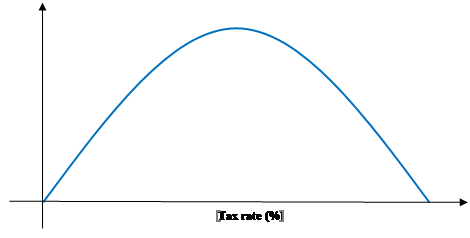
The key idea of Laffer is that the tax rate increasing leads to an increase in tax revenues only up to a certain point. After that, tax revenues to the budget are reduced. On the one hand, the termination of the official economic activities of economic entities is observed. On the other hand the growth of the shadow economy occur, as business can not afford too high reduction in profitability (Malcomson, 1986).
Naturally the Laffer curve is rather relative. In practice, in addition to tax rates, one should also consider the type of taxation system, time ranges, the initial levels of tax rates, the availability of various tax incentives, tricks and gimmicks of entrepreneurs, etc.
Understanding Laffer's idea requires students to have a certain basic knowledge of terms, vocabulary and mathematical apparatus. Otherwise, the explanation of the professor will not be clear to the students.
By the time the Laffer curve is studied, students need to know the concept of tax, types of taxes (direct, indirect, etc.), understand the meaning of the term tax burden and its components, the concept of profitability, fiscal policy etc.
From the point of view of the mathematical apparatus, students should be able to solve equations, construct graphs of functions, understand the features of the influence of the function argument on its behavior, understand the behavior of parabolic functions, be able to calculate and interpret derivatives, extremum points, etc.
One of the important aspects of the Laffer theory is the probability of the economy falling into the tax trap, in which tax rates are set at a level that the net profit after paying all taxes becomes lower than the average interest on the deposit.
In the conditions of the trap, capital flows into the banking sphere, the economy slows down and, consequently, the taxable base decreases.
The conditional nature of the curve lies in the fact that all taxes must be taken into account at once (Soldatos, 2015).
Lorentz curve is another graphic model that deserves attention. It gives the opportunity to judge the degree of inequality in household income (Figure
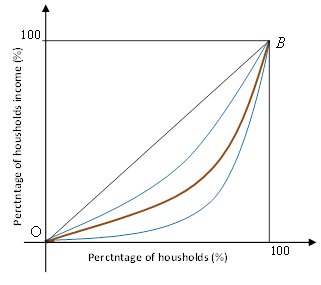
The percentage of households is shown on the abscissa axis, and the percentage of household incomes is on the ordinate axis. The absolutely equal income distribution is represented by the bisectrix. In practice, it never happens (Jasso, 2018).
The area between the line denoting absolute equality (bisectrix) and the Lorentz curve indicates the degree of income inequality. The larger this area, the greater the degree of income inequality.
The Lorenz curve is used to compare the distribution of income in different periods of time, in different countries, regions, etc.
Macroeconomic equilibrium can be described using the graphical model (Figure
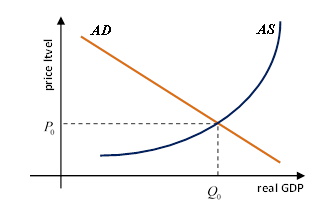
Macroeconomic equilibrium occurs at the intersection of the aggregate demand (AD) and aggregate supply (AS) curves. Aggregate demand (AD) is the total demand for goods and services that households in a national economy plan and are able to buy during a specific time period. Aggregate supply (AS) is the total supply of goods and services that firms in a national economy plan to sell during a specific time period. Equilibrium need not be at the full employment level of GDP.
Aggregate supply has three stages: keynesian, classical and intermediate. (Figure
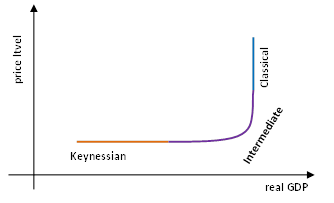
The Keynesian aggregate supply curve shows that the aggregate supply curve is significantly horizontal implying that the firm will supply whatever amount of goods is demanded at a particular price level during an economic depression (short run aggregate supply SRAS) (Nevile, 2016). Classical view of aggregate supply (long run aggregate supply LRAS) states that aggregate supply is not determined by the price level or aggregate demand (AD), but is determined by factors of production – land, labour, capital and labour productivity (Birol, 2015).
Changes in aggregate supply and aggregate demand cause shifts along the supply curve and demand curve.
The demand shock is sudden event that increase or decrease demand for goods or services temporarily. The supply curve is the same event for supply. In these cases demand and supply curves shift to the right or to the left depending on the situation (Figure
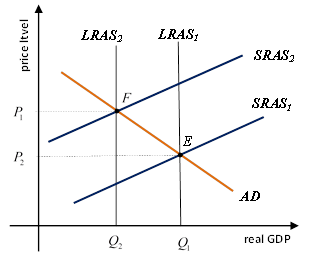
All models described above are studied in the course of economic theory (in particular, macroeconomics), and then used in the study of other disciplines in the explanation of various economic processes.
Thus, the actual language propaedeutics is a constant dynamic process, beginning with the study of a general language and constantly deepening while studying professional disciplines.
Findings
It’s common knowledge that at present there is hardly any academic discipline where students would not need a foreign language, mostly English as a language of international communication, for understanding professionally oriented educational texts and carrying out the tasks connected with their study. In this regard, the initial activity pertaining to teaching special disciplines, or language propaedeutics, should primarily involve language training which is largely enhanced by engaging in the subject areas.
The need for propaedeutics in regard to graphic modeling of economic processes closely relates firstly to the choice of vocabulary used and the appropriate range of grammar and lexis, and, secondly, helps them to master practical skills in a way that engages students in the actual practice of using mathematical tools and dynamic modelling. Risk analyses may be considered a branch of economics where such skills are a must and in high demand.
Furthermore, the analysed educational process is actually dual language instruction, where English and the native language or the language of the host country combine in a certain ratio. In the situations under discussion bilingualism is supplemented by the third language, the language of mathematics, which is highly ritualized and international in its nature.
Thus, language propaedeutics for training in graphic modeling of economic processes must be based on the preceding linguistic preparation to graphic simulation. Propaedeutics also comprises working out those grammar forms and structures which are the most characteristic of these educational activities.
Yet another aspect of language propaedeutics for the study of any special discipline is cross-disciplinary cooperation (Stepanyan, Dubinina, Nikolaev, Kapranova & Pashtova, 2017). Cross-disciplinary approach allows instructors to make the learning process more intense and interactive, as students are offered the accumulated knowledge of several disciplines. Moreover, the formation of interdisciplinary teams of educators helps to increase students’ sense of membership (Rumsey, 1999).
Conclusion
Having analysed the experience and outcomes of instruction in modeling economic processes intended for international as well as Russian students the authors draw the following conclusion.
Language propedeutics should primarily involve language training starting with the choice of vocabulary used and the appropriate range of grammar and lexis.
The specificity of obtaining economic education in the context of modern educational standards suggests that language propedeutics should not be perceived solely as the study of a foreign language as a philological discipline. It should be taken into consideration that teachers of a foreign language have to a certain extent limited knowledge in matters of mathematical apparatus, as well as the intricacies of economic processes and phenomena.
The study of specific specialized terms is possible only in specific disciplines, such as mathematics, which, in turn, will serve as the basis (the next stage of language propaedeutics) for understanding didactic units of subsequent professional disciplines.
A cross-disciplinary approach to language propaedeutics makes it possible to develop understanding the essence of phenomena, processes, factors involved in modeling and find the necessary approach and methods of solving the tasks.
References
- Berezina, O.V. (2010). Osobennosti propedevticheskogo kursa po inostrannomu yazyku dlya detej starshego doshkol'nogo vozrasta [Features of the propaedeutic course on a foreign language for children of senior preschool age]. Modern trends in teaching foreign languages and cultures: materials of international conference. March 25, 2010 (pp. 120-124). Elektrostal: The New Humanities Institute. [In Rus.]
- Birol, O.H. (2015). What It Means to be a New Classical Economist. Procedia - Social and Behavioral Sciences, 195(3), 574-579. doi: 10.1016/j.sbspro.2015.06.136
- Clifford, M. (2014). Facilitating Collaborative Learning: 20 Things You Need to Know From the Pros. Retrieved from https://www.opencolleges.edu.au/informed/features/facilitating-collaborative-learning-20-things-you-need-to-know-from-the-pros/
- Curado-Fuentes, A., & Rokowski, P.E. (2003). Using Corpus Resources as Complementary Task Material in ESP. English for Specific Purposes World, 3(6). Retrieved from http://www.esp-world.info/articles_6/C2_.htm
- Dudley-Evans, T., & St John, M. (1998). Developments in English for specific purposes: a multi-disciplinary approach. Cambridge: Cambridge University Press.
- Jasso, G. (2018). Anything Lorenz Curves Can Do, Top Shares Can Do Assessing the TopBot Family of Inequality Measures. Sociological Methods & Research. doi: 10.1177/0049124118769106
- Kletz, T.Y. (2015). K voprosu ob ispol'zovanii predmetno-yazykovogo integrirovannogo obucheniya CLIL v sisteme inoyazychnoj podgotovki studentov [On the content and language integrated learning (CLIL) in students’ language training]. Foreign languages: linguistic and didactic aspects, 30, 83-89. [In Rus.]
- Konnova, L.P., Rylov, A.A., & Stepanyan, I.K. (2016). Ekonomicheskie prilozheniya vysshej matematiki v kejsah: uchebnoe posobie [Economic applications of higher mathematics in case studies: a tutorial]. Moscow: Financial University Publ. [In Rus.]
- Lependin, M.I. (2007). Povyshenie ehffektivnosti professional'no orientirovannogo obucheniya inostrannomu yazyku studentov starshih kursov neyazykovyh fakul'tetov [The Increase the effectiveness of professionally oriented teaching foreign language for senior students of non-linguistic faculties]. (Doctoral dissertation). Retrieved from https://dlib.rsl.ru/viewer/01003061041#?page=1 . [In Rus.]
- Malcomson, J.V. (1986). Some analytics of the Laffer curve. Journal of Public Economic, 29(3), 263-279. doi: 10.1016/0047-2727(86)90029-0
- Marsh, D. (2002). CLTL / EMILE – the European Dimension: Actions, Trends and Foresights Potential. Brussels: The European Union. Retrieved from http://userpage.fu-berlin.de/elc/bulletin/9/en/marsh.html
- Meyer, J., & Land, R. (2003). Threshold Concepts and Troublesome Knowledge:Linkages to Ways of Thinking and Practising within the Disciplines (Occasional Report 4). Retrieved from ETL Project, Universities of Edinburgh, Coventry and Durham, 2003. Information website: https://kennslumidstod.hi.is/wp-content/uploads/2016/04/meyerandland.pdf
- Meyer, J., Land, R., & Baillie, C. (2010). Threshold concepts and transformational learning. Educational futures Rethinking theory and practice, 42. Retrieved from http://www.lamission.edu/learningcenter/docs/1177-threshold-concepts-and-transformational-learning.pdf
- Nevile, J.W. (2016). Notes on Keynes’ Aggregate Supply Curve. Post-Keynesian Essays from Down Under Volume I: Essays on Keynes, Harrod and Kalecki. Palgrave Macmillan, London. doi: 10.1057/9781137475381_4
- Nikolaev, D.A. (2017). Innovacionnye idei i podhody k integrirovannomu obucheniyu inostrannym yazykam i professional'nym disciplinam v sisteme vysshego obrazovaniya [Case analysis as a method of content and language integrated learning Innovative ideas and approaches to integrated teaching of foreign languages and professionally orientated subjects in high education]. Proceedings of the International Methodological Training Conference on March 27-30, 2017, pp. 372-374. St. Petersburg: Publishing house Polytechnic. University. [In Rus.]
- Rumsey, D.J. (1999). Cooperative teaching opportunities for Introductory Statistics teachers. Mathematics Teacher, 92(8), 734-737. Retrieved from https://www.nctm.org/Publications/mathematics-teacher/1999/Vol92/Issue8/Cooperative-Teaching-Opportunities-for-Introductory-Statistics-Teachers/
- Soldatos, G. (2015). Tax Aversion, Laffer Curve, and the Self-financing of Tax Cuts. Applied Economics and Finance, 2(2). doi: 10.11114/aef.v2i2.714
- Stepanyan, I.K., Dubinina, G.A., & Ganina, E. (2017). Bilingvalnyj podxod k-obucheniyu matematike inostrannyh studentov [Bilingual approach to teaching mathematics to foreign students]. International Research Journal, 12 (66). doi: 10.18454/IRJ.2227-6017
- Stepanyan, I.K., Dubinina, G.A., Nikolaev, D.A., Kapranova, L.D., & Pashtova L.G. (2017). Cross-Disciplinary case-analyses of investment optimization in a foreign language applying dynamic programming. Espacios, 38(62), 19. Retrieved from http://www.revistaespacios.com/a17v38n62/a17v38n62p19.pdf
Copyright information

This work is licensed under a Creative Commons Attribution-NonCommercial-NoDerivatives 4.0 International License.
About this article
Publication Date
30 December 2018
Article Doi
eBook ISBN
978-1-80296-050-1
Publisher
Future Academy
Volume
51
Print ISBN (optional)
-
Edition Number
1st Edition
Pages
1-2014
Subjects
Communication studies, educational equipment,educational technology, computer-aided learning (CAL), science, technology
Cite this article as:
Dubinina, G. A., Stepanyan, I. K., & Nikolaev, D. A. (2018). Language Propaedeutics For Instruction In Graphic Modeling Of Economic Processes. In V. Chernyavskaya, & H. Kuße (Eds.), Professional Сulture of the Specialist of the Future, vol 51. European Proceedings of Social and Behavioural Sciences (pp. 998-1007). Future Academy. https://doi.org/10.15405/epsbs.2018.12.02.108

